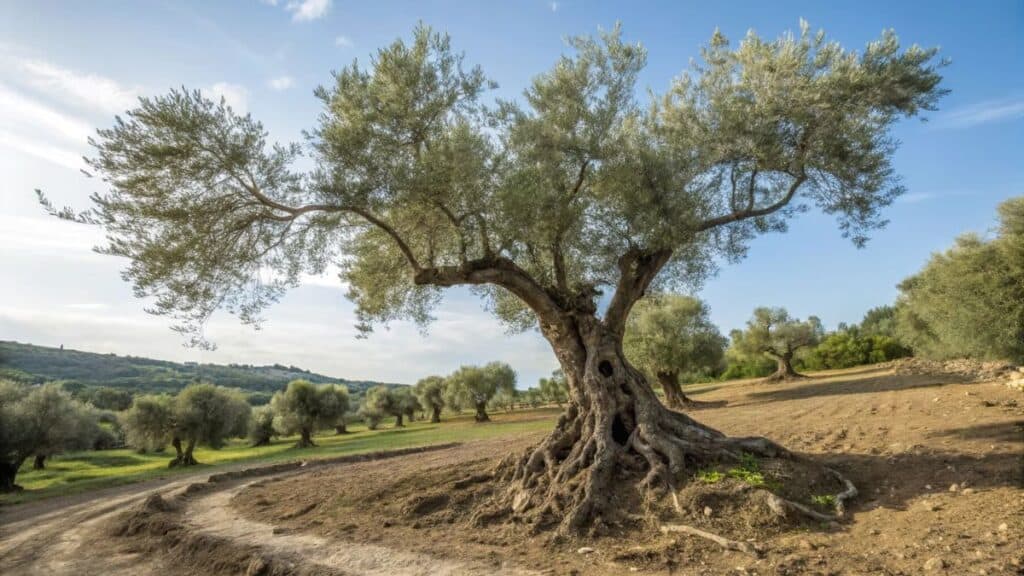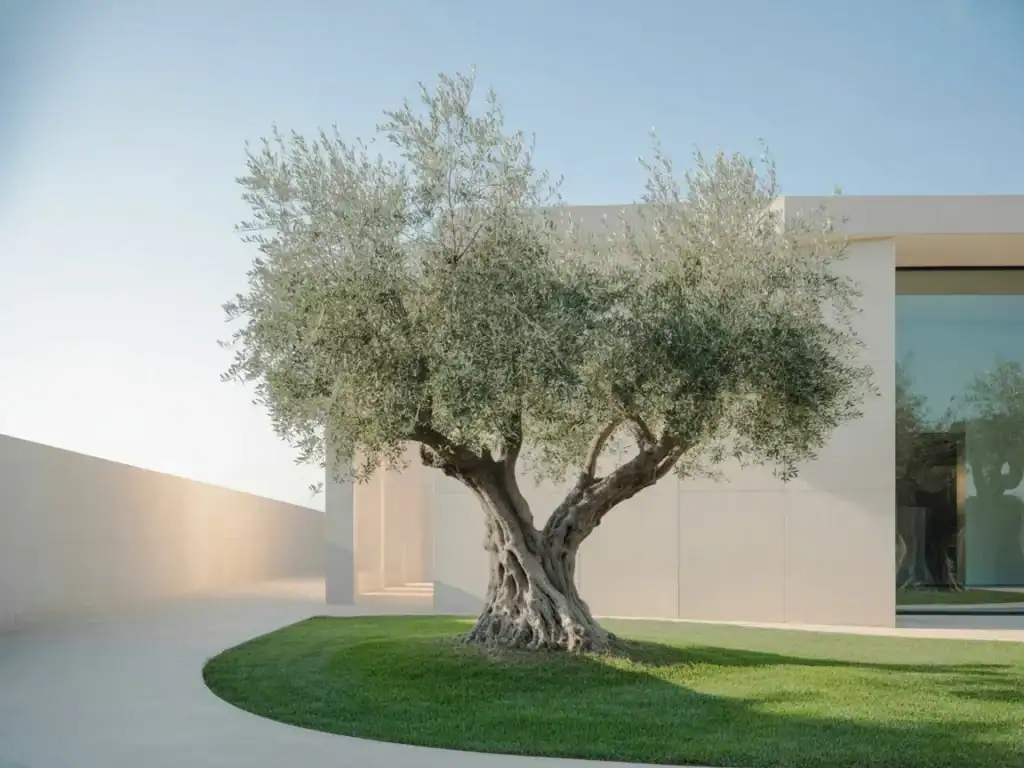Are Olive Tree Roots Invasive?
Olive Knowledge is a part of Amazon Associates. As an Amazon Associate, we earn from qualifying purchases. Read our Affiliate Disclosure to learn more.
If you’d like to plant an olive tree near some objects around your house, you should ensure that the roots won’t cause any trouble.
In this post, I’ll show you whether or not olive tree roots are invasive and whether you can plant them next to sidewalks, basements, etc.
Key Takeaways:
- Olive trees have shallow roots, and they’re not considered invasive.
- Olive tree roots usually don’t grow too wide. They’re usually the same width as the tree crop.
- It’s still recommended to plant larger olive trees further away from the houses, sidewalks, foundations, etc.
Olive Tree Roots Aren’t Invasive

Olive tree root systems are not considered invasive. In fact, they are actually quite shallow-rooted.
The main roots (thick ones) generally grow only up to 3 feet deep. However, in the search for water, root veins can go up to 30 feet deep.
This is shallower than the roots of most other types of trees. As a result, olive trees are not as likely to damage sidewalks, driveways, or foundations as other trees.
What does this mean for you? If you’re considering planting an olive tree, then you don’t need to worry about the roots being invasive.
Olive Tree Roots Size Depends on the Variety

The size and spread of olive tree roots are closely related to the olive variety you plant. Larger olive tree varieties naturally develop thicker, wider, and deeper root systems, sometimes reaching up to 30 feet (9 m) in depth when searching for water.
Examples of larger olive tree varieties (with bigger roots):
- Picual (Spain)
- Kalamata (Greece)
- Coratina (Italy)
- Leccino (Italy)
- Verdale (France)
On the other hand, smaller and more compact olive tree varieties usually develop shallower, less aggressive roots (typically 2–6 feet deep, with lateral spread close to the canopy).
Examples of smaller olive tree varieties (with typical root growth):
- Arbequina (Spain)
- Koroneiki (Greece)
- Manzanilla (Spain)
- Frantoio (Italy)
- Pendolino (Italy)
👉 Practical tip: If you’re planning to plant an olive tree close to your house, driveway, or underground utilities, it’s safer to choose varieties from the second group (Arbequina, Koroneiki, Manzanilla, Frantoio, Pendolino). These are less likely to cause structural issues.
Are Olive Tree Roots Strong?
Olive tree roots are considered very strong and resilient. Their strength comes not only from their shallow but widespread root system, which firmly anchors the tree in place, but also from the nature of the olive tree itself.
Olive wood is known for being exceptionally dense and hard (with a higher density than oak) – Its density is about 62 lbs/ft3 (990kg/m3), which reflects the overall toughness of the tree, including its roots. This makes olive trees remarkably resistant to strong winds, droughts, and poor, rocky soils where many other trees would struggle.
In practice, olive tree roots are strong enough to secure the tree against being uprooted by storms, while also flexible enough to grow between rocks and adapt to challenging Mediterranean landscapes.
Properties of Olive Tree Roots
Here are some general properties of olive tree roots you should be aware of:
- Safe for other trees. Olive tree roots are not toxic to other trees. This means that you can plant other trees near olive trees without worrying about the roots damaging them.
- Shallow-rooted. As we mentioned before, olive tree roots are relatively shallow. The average olive tree has roots that only grow to about 3 feet deep. This is shallower than the roots of most other types of trees.
- Great for rocky soil. Olive trees are well-suited for rocky soil. This is because their roots can grow in between the rocks, which helps to anchor the tree in place.
- Fine for grassy yards. Olive tree roots are also fine for grassy yards. The roots are not likely to damage your lawn, and the tree can actually help to aerate the soil.
Where Is It Safe To Plant Olive Trees?

To make it easier for you, I’ve created a simple table so you can see locations where it’s safe to plant olive trees, or not. Here’s a quick table with more thorough information on where you should and shouldn’t plant olive trees:
| ✅ Suitable Locations | ❌ Locations to Avoid |
|---|---|
|
Open fields or orchards Lots of space for root expansion without risk to structures. |
Near foundations of buildings Roots can cause cracks or moisture problems over time. |
|
20–30 feet from structures Safe distance from houses, garages, and fences. |
Close to underground pipes Roots may penetrate pipes in search of water. |
|
Next to other trees Non-invasive roots allow companion planting. |
Next to paved surfaces Roots may lift or crack sidewalks and driveways. |
|
In larger home yards Ideal for landscaping and shade if space allows. |
Near septic tanks Roots are attracted to moisture and can cause blockages. |
|
Well-drained soil areas Olive roots thrive in rocky, aerated soils. |
Small yards Limited space may not allow safe root spread. |
Frequently Asked Questions
Here are answers to some frequently asked questions on this topic. I’ve received plenty of emails regarding this topic, so I decided to share the most common ones here.
Olive tree roots are generally shallow and not considered highly invasive. However, large varieties planted too close to buildings can still cause cracks in foundations or draw moisture away from the soil, leading to shifting. To be safe, always plant olive trees at least 20–30 feet (6–9 m) away from foundations.
In most cases, olive tree roots don’t have the same aggressive lifting power as species like oaks or maples. Still, if planted right next to paved surfaces, they may cause slight lifting over time. Keeping a safe planting distance will prevent this issue.
Most olive tree roots grow within the top 2–3 feet (60–90 cm) of soil, which makes them shallow compared to many other trees. In dry climates, finer root systems may extend deeper (up to 20–30 feet/6–9 m) in search of water.
Bigger olive tree varieties like Picual, Kalamata, Coratina, Leccino, and Verdale tend to have thicker and deeper roots. Compact types such as Arbequina, Koroneiki, Manzanilla, Frantoio, and Pendolino have smaller, less invasive root systems—making them more suitable for small yards.
Yes, if planted too close. Like many trees, olive roots naturally grow toward water sources. If there are cracks in underground pipes or leaky septic tanks, roots can penetrate and cause blockages. Keep olive trees at least 30 feet (9 m) from any underground utilities.
Yes – especially smaller varieties. Olive tree roots are not toxic to other plants and won’t damage grass. In fact, they can help improve soil aeration. Just ensure your garden has enough space for the tree’s canopy and root spread.
Similar Posts:
